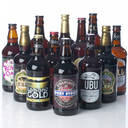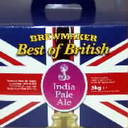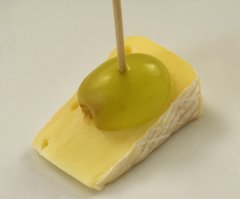Want to Pair British Cheeses
with Wines, Ales and Ciders?

Deciding how to Pair British cheeses (or any other cheeses) with the right wine, ale, cider or beer ... can be confusing for sure. But the best advice I can give you is to keep it simple.
Don't agonize over your choices. Be bold,
experiment and be aware of a few guidelines which can help you. You
probably have heard of advice like ... "red wine works better with
cheese than white wine" ... or ... "if you serve a strong cheese you
must serve a full-bodied robust wine". Not
necessarily so! The best approach is to try as many different
cheese-wine pairings as possible ... and then decide which pairing(s)
work best for you. You won't want to have the cheese overpower the
wine, or vice versa.

So one suggestion is to pair a strong, complex cheese with a simple wine ... or pair a simple, rustic cheese with a more robust, flavorful wine. For example, a big Red Bordeaux would pair well with a Farmhouse Cheddar or Caerphilly. A washed-rind cheese like an Époisses de Bourgogne (strong and stinky) would pair well with a bright white wine like a Gewürztraminer. Another suggestion is to pair local wines (ales or ciders) with local or regional cheeses. The ciders in Britain work well with quirky cheeses like Slack Ma Girdle and Stinking Bishop, just as northern French beers and ales work well with northern French, Belgian and Dutch cheeses. Brews like these would also be terrific to pair with British Cheeses, or Dutch, Swiss and Danish cheeses.
One last point ... be sure to serve your cheese selections at the proper room temperature ... and serve the wines at their recommended serving temperatures. Take a bite of cheese, with a sip of wine ... let the flavors mingle in your mouth before swallowing. You will know if you like, love or hate the combination!
The suggested pairings I show below are just that ... suggestions. If you have no clue where to begin, then begin with some of these suggestions. There is such a wide range of wines to choose from, with prices from inexpensive to very pricey, that you'll have no trouble finding suitable wines at the supermarket, liquor store or wine shop. If you are lucky enough to have a local wine shop in your town with a knowledgeable owner, you are already 10 steps ahead of the pack when it comes to deciding how to Pair British Cheeses or French, Italian, American etc.!
Cheese Pairings
FARMHOUSE CHEDDAR:
Red wines: Merlot, Red Bordeaux, Red Rhône Syrah, California Pinot Noir, Rioja
White wines: White Burgundy, Sauvignon Blanc
Fortified wines: Port, Madeira
Sparkling wines: Champagne (Brut)
Ales: Dark Ales and Beers
FARMHOUSE CHESHIRE:
Red wines: Beaujolais (Cru - Gamay grape)
White wines: California Chardonnay, Pouilly-Fumé, Riesling
Fortified wines: Sherry
Sparkling wines: Moscato d'Asti
Ales: Try a variety of British Ales
CAERPHILLY:
Red wines: Red Rhône Syrah, Red Bordeaux
White wines: Dry Whites such as Vouvray, Gewürztraminer
Sparkling wines: Moscato d'Asti
Ales: Wheat Ale
DOUBLE GLOUCESTER:
Red wines: Light-bodied Reds - Pinot Noir, California Zinfandel
White wines: White Burgundies, Sancerre
Ales: Try a variety of British Ales
LANCASHIRE:
Red wines: Soft red wines - California Pinot Noir, Rhône Syrah, California Cabernet Sauvignon
White wines: Gewürztraminer
STILTON:
Red wines: Robust, full-bodied reds - California Cabernet Sauvignon, Red Bordeaux, Tuscan Reds
White wines: Sauternes
Fortified wines: Port, Madeira, Sherry
Sparkling wines: Moscato d'Asti
STINKING BISHOP:
Ciders: Try Brothers Pear Cider
SLACK MA GIRDLE:
White wines: Sauvignon Blanc
Ciders: Try a variety of British Ciders such as Scrumpy Jack (by H.P. Bulmer), Gaymer Ciders, Thatcher's Ciders, Brothers Ciders
GUBBEEN:
White wines: Chenin Blanc, Riesling, Vouvray, Gewürztraminer
COOLEA:
Red wines: Soft and fruity red wines - California Zinfandel, Red Rhône Syrah, Beaujolais (cru), California Pinot Noir
TICKLEMORE:
Red wines: California Cabernet Sauvignon
White wines: Soave, German Riesling, Tokay Pinot Gris (Alsace)
SPENWOOD:
Red wines: Red Burgundies, Chianti, Red Rhône Syrah, Rioja
White wines: Chenin Blanc, Vouvray, Gewürtztraminer
BEENLEIGH BLUE:
Red wines: California Cabernet Sauvignon, Beaujolais (cru), California Zinfandel
White wines: Riesling, Sauternes
Fortified wines: Port
HARBOURNE BLUE:
White wines: Chenin Blanc, Gewürztraminer
Sparkling wines: Moscato d'Asti
SHROPSHIRE BLUE:
Red wines: California Cabernet Sauvignon, Côte du Rhônes
White wines: California Chardonnay
Fortified wines: Port, Sherry, Madeira
British Ciders & Ales

British Ciders: There are two main traditions in cider-making in Britain. The first is in Western England. Here the Ciders are cloudy, non-carbonated and unfiltered - and are often called "scrumpy" or "scrump" (referring to small, withered apples).
Well-known makers include: Thatcher's Cider, Brothers Cider, Gaymer Cider and Scrumpy Jack made by H.P. Bulmer. These would be wonderful with Slack Ma Girdle cheese.
Kent and East Anglia produce a second type of Cider which is made from dessert fruits like pears and raspberries. Look for Biddenden's, Rough Old Wife (!) and Theobalds. Brothers makes a fine Pear Cider (drink with Stinking Bishop cheese). St. Helier makes Raspberry, Pear, Apple and Blueberry Ciders. These Ciders from Kent and East Anglia are clearer and lighter in body and flavor than the Western England varieties.
ALES in Britain are made in various styles:
Bitter ... Ordinary Bitter contains up to 4.1% alcohol by volume; Best Bitter contains 3.8-4.7% abv; Premium Bitter contains 4.8% abv. Overall Ales range from 3 1/2 to 7% alcohol by volume.
Brown Ale - Mann's Original Brown Ale, Samuel Smith's Nut Brown Ale

Golden Ale - Pale in color like a
lager with 4-5% abv. India Pale Ale is a well-known brand.
Mild - Sarah Hughes Ruby is one example. Mild ale is darker, sweeter and a bit less alcoholic.
Old Ale - Dark, malty beers fondly referred to as "Winter Warmers". Theakston's Old Peculiar, Robinson's Old Tom are two good brands to seek.
Porter and Stout - Porter developed in 18th c. London and is the ancestor to Stout, a style now considered to be typically Irish. Stouts and Porters are dark brown to pitch black ales, and more bitter in taste than old ales. Their taste can range from very sweet to very dry, with alcohol contents from 4-7% or higher. They pair up well with soft, washed-rind cheeses and with blue cheeses.
Lager - The traditional British "Beer" is Ale. However, more than 50% of the British market is now Lager in the Pilsner, lighter colored style. Carling and Foster are two very well known brands.
Beers/Ales are served in Britain at 50-57
degrees, not warm room temperature as Americans so often think! So, with
this very brief primer on Ales and Beers, you can confidently walk into a British Pub and ask for a "Pint of Best Bitter please!" But you can also find many of these Ales in American supermarkets - so try a few when you Pair British Cheeses with drinks for your next party.
Check out the links below to learn about some special British Cheeses to try!
Go to British Cheese
Go to Farmhouse Cheddars
Go to Quirky Notable British Cheeses
HOME › Pair British Cheeses

Looking for something specific on GourmetCheeseDetective.com?
Enter your request below:
Follow The Gourmet Cheese Detective on Twitter: @The_Cheese_Tec
Oi! Read Up On Great British Cheese!
Great British Cheeses by Jenny Linford

The first visual guide to Britain's popular farmhouse cheeses, it describes over 300 specific varieties from around the British
Isles. Engaging text showcases the best new and traditional cheese
varieties, as well as the lives and techniques of the independent
farmers and cheese-makers who create them. The book concludes with a
directory of suppliers. Click on the image to order your copy! - G.C.D.
British and Irish Artisan Cheeses!
The Real Cheese Companion: A Guide to Best Handmade Cheeses of Britain and Ireland by Sarah Freeman

A new generation of artisan cheesemakers is now producing not only the
hard cows’ milk and blue cheeses usually associated with Britain, but
also soft cheeses of the Brie and Camembert variety, hard sheep’s
cheeses, both hard and soft goat cheeses, and a small but growing number
of organic and buffalo cheeses. Click on the image above to order a copy! - G.C.D.
Take a New Look at British Food
British Food: An Extraordinary Thousand Years of History by Colin Spencer

Until the middle of the 19th century, English cuisine was known
throughout Europe as extraordinarily stylish, tasteful, contemporary, and designed to satisfy the most sophisticated palates. So why did British food "decline so direly that it became a
world-wide joke, and how is it now climbing back into eminence?" This
delectable volume traces the rich variety of foods that are inescapably
British -- and the thousand years of history behind them. Click on the image to place your order now! - G.C.D.
Visit the North London shop Le Fromagerie
The Cheese Room by Patricia Michelson

Patricia Michelson is passionate about cheese, and her wonderful North
London cheese shop, Le Fromagerie, reflects this in its unique stylish way. One
of the best-loved cheese shops in Britain, its shelves are bursting
with all kinds of delicious varieties. Click on the image and take a tour! - G.C.D.
American Food and the British Ex-pat
The British Expat's Guide to Grocery Shopping in America by Maxine Cleminson

Moving to America may seem quite a straight- forward transition as expat
re-locations go. After all, they speak English, right? However, there
are still many things that are lost in translation and it can be
frustrating trying to find familiar foodstuffs, especially when catering
for a family. This book covers it all... and not just the obvious
pitfalls of differing pronunciation! Click to order your copy of sanity today! - G.C.D.

